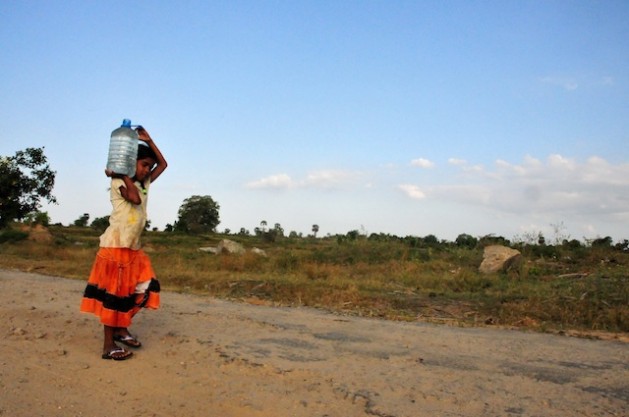Thursday, April 25, 2024
News and Views from the Global South
Water & Sanitation
Rural Water Projects Depend on Women

In rural Sri Lanka women are tasked with fetching and carrying water for the entire household, sometimes walking miles with pots and bottles balanced on their heads. Credit: Amantha Perera/IPS
- During the dry season, when dirt roads are cracked from the relentless heat, the sight of women walking miles, balancing pots of water on their heads, is common in rural Sri Lanka.
While the men tend to paddy fields, the women are left with the arduous task of collecting water for household use. They account for every drop of water consumed, utilised or wasted – making them crucial players in rural water projects.
Talpothta is a typical agricultural village in Sri Lanka’s dry zone, whose life cycle is completely dependent on the rainfall that has become extremely erratic in the last few years.
In 2006, the village was chosen as one of the beneficiaries of a 263-million-dollar Asian Development Bank (ADB) project that set out to provide safe drinking water to 900,000 people in Sri Lanka’s north-central and eastern provinces.
But unlike many other development projects in the country, this is led primarily by women, who comprise an overwhelming majority of the village community.
From the initial planning stages, village women were inducted into the project’s long-term implementation plans, which included installing a community-run water storage tank and mapping out a distribution network to link the entire village to the water supply.
The project’s community leaders advise the roughly 200 village water users, check metres, collect payments and, most importantly, decide when and how to limit the water supply when the dry season sets in. Members also visit households regularly and keep close tabs on usage.
Sheila Herath, a member of the group of local leaders, says women play a critical role in this project.
“The woman in the household is the person who will know how much water is used for what. So we know how much is needed and how much is excess,” she said.
The ADB project planners knew this from experience, not only in Sri Lanka but in other parts of rural South Asia, officials told IPS, adding that 50 percent of participants at planning meetings and at least 25 percent of the officials from the government Water Board were women.
According to Attanayake Mudiyanse Senevirathana, a public official in the north-central town of Polonnaruwa working on improving access to safe water, women have traditionally played the role of ‘water bearer’.
“This is still the case,” he told IPS, adding, “Women also feel they gain more by the success of such projects.”
Thanks to the new water project, women in Talpothta say they find themselves with a lot more free time – something that most rural women can only dream of.Forty-five-year-old Liyadurige Siriyawathi has returned to a childhood hobby that she gave up when she got married two decades ago – making sketches. She now earns about 100 dollars a month from the sales of these drawings.
Others are engaged in home gardening or say that they now have more time for themselves or for the children.
Kusum Athukorale, who heads the Network of Women Water Professionals in Sri Lanka, told IPS that one sixth of the island’s water supply is derived from rural community projects. Their success depends on women’s participation at every level, she stressed.
“They are the ones who know where the water sources are, how much is needed. They the ones who walk miles to gather water when drought sets in.”
Athukorale calls women the “foot soldiers of climate change adaptation” because of their hands-on knowledge of how natural resources are being used in households.
A recent ADB report entitled ‘Gender and Urban Poverty in South Asia’ found that women’s role in water management was crucial throughout the region.
“Health surveys conducted in 45 developing countries during 2005–2008 showed that globally, women bear the largest burden as primary collectors of water in 64 percent of households, compared with 24 percent of households for men, four percent for boys, and eight percent for girls,” the report stated.
The report warned that women, especially those from poor communities, were at risk of suffering more due to lack of access to safe water “as they are the primary users, providers, and managers of water in households and are responsible for household hygiene.”
The report detailed projects in Bangladesh, India, the Maldives, and Nepal similar to the Talpothta water scheme, where women played a crucial role in ensuring success.
A women’s group in the village of Ramnagara, a town in the central Indian state of Madhya Pradesh, was responsible for lobbying local authorities and a non-governmental group to establish pipes close to their homes. Like in rural Sri Lanka, the new pipes freed up time the women would otherwise have spent searching for water.
“Women now use the time saved to participate in group activities and explore other livelihood options,” the ADB report said.
“There is an accumulation of evidence to show that if we are able to (appoint) women as the decision makers for a project on the ground, the success rate goes up almost instantly,” Naoko Ishii, chairperson of the Washington-based Global Environment Facility (GEF), a public fund that assists in projects related to sustainable development, told IPS.
Ishii, who served as Japan’s deputy finance minister and as country head for the World Bank in Sri Lanka before taking up the GEF top post, credits women’s sense of discipline as a key factor in their pivotal role, especially in rural Asia and Africa.
“When women are in charge of a micro finance project, the repayment ratio is much higher,” she told IPS.
-
zlop

 Print
Print



